EXPLANATORY NOTE
This special release presents data on births that occurred in 2022. Statistics were based on the usual place of residence of mother. The figures in this annual publication are derived from the vital events registered at the Local Civil Registry Offices throughout the Philippines, whether late or timely.
Live birth decreases by 6.3 percent
The City of Marikina recorded a total of 5,296 live births in 2022, a decrease of 6.3 percent from the 5,653 live births posted for the year 2021. This translates to 15 babies born daily, on the average.
Of the total registered live births, 2,712, or 51.2 percent, were males and 2,584, or 48.8 percent, were females.
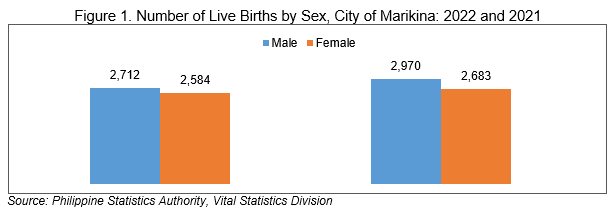
Among the live births, 5,133, or 96.9 percent, were timely and 163, or 3.1 percent, were registered late.

Some babies are delivered outside Marikina
Three in every 10 babies were born outside the usual place of residence of the mother—City of Marikina. Some of the birth deliveries took place in nearby cities within the National Capital Region, while others occurred in other regions.
Among those born outside the City of Marikina, the highest were recorded in Angono, Rizal, with 654 (12.3%), and in Quezon City, with 620 (11.7%).
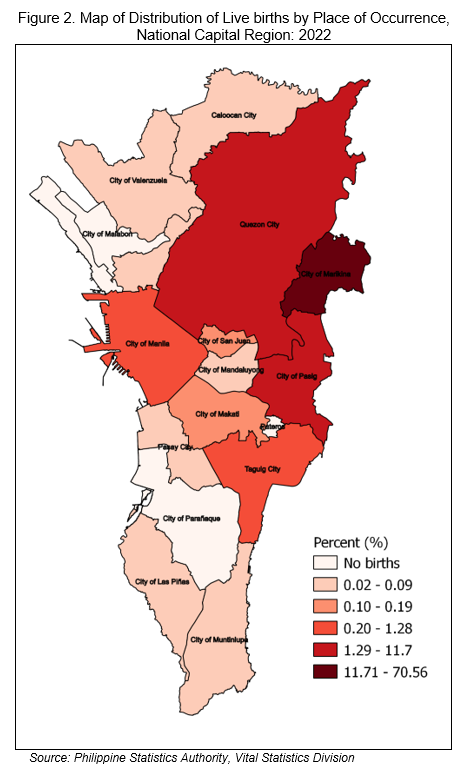
September records the most live births in 2022
The number of live births shows fluctuations across the months in 2021 and 2022. In both years, September consistently recorded the highest number of live births, with 577 in 2021 and 564 in 2022.
The number of babies born in September 2022 averages to 18 each day.

98 in every 100 births are medically assisted
Health professionals (physicians, nurses, and midwives) attended 97.8 percent of registered birth deliveries in the City of Marikina, a notable increase from 2021, when 97.1 percent of the total registered live births were medically attended.
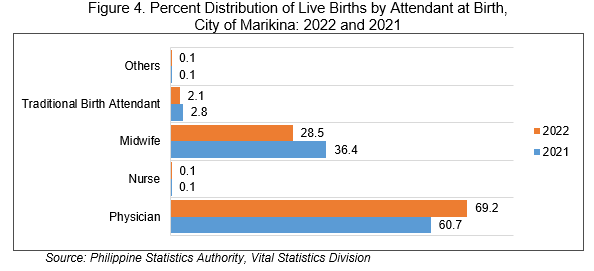
Among the medically attended live births, 5,119, or 98.8 percent, were born at the hospital, while 59 were delivered at home and two elsewhere.
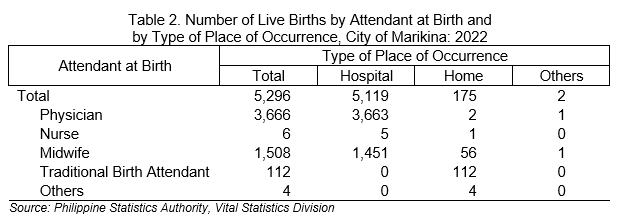
About two out of three live births are nonmarital
There were 3,614 babies, or 68.2 percent, in 2022 were born outside marriage. This was lower by 307, or 1.1 percentage points, in the previous year.
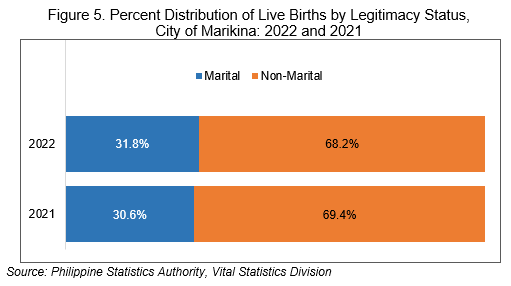
Decline in teen births seen in Marikina
The highest percentage of live births was delivered by mothers aged 20 to 29, with 2,652, or 50.1 percent of the total registered live births. This was slightly lower than the 2021 record of 2,859, which was delivered by a mother in the same age group.
The average age at which a woman gave birth was 28 years.
Compared to 2021, the year 2022 showed a decrease in the number of live births to mothers residing in the City of Marikina to 340 live births—accounting for 6.4 percent of the total registered live births. The youngest teen mother recorded in the city for 2022 was 12 years old.
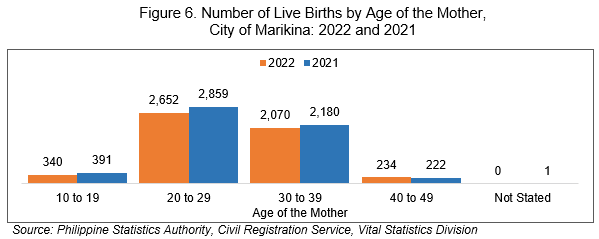
Nearly one in ten live births are classified as low birthweight
Out of 5,296 total registered live births, 4,644, or 87.7 percent, weighed 2,500 grams or more, while the remaining 652, or 12.3 percent, were classified as low birthweight (less than 2,500 grams).
From 2021 to 2022, the percentage of low birthweight babies rose by 5.3 percent.

TECHNICAL NOTES
Introduction
Vital statistics are derived from information obtained at the time when the occurrences of vital events and their characteristics are inscribed in a civil register.
Vital acts and events are the births, deaths, fetal deaths, marriages, and all such events that have something to do with an individual's entrance and departure from life together with the changes in civil status that may occur to a person during his lifetime. Recording of these events in the civil register is known as vital or civil registration and the resulting documents are called vital records.
Definition of terms and concepts
Significant terminologist and descriptions in the foregoing highlights and tables are defined below. Included are some items found in the certificates and summary measure used in describing the facts of events.
Live Birth is a complete expulsion or extraction from its mother of a product of conception, irrespective of the duration of the pregnancy, which after such separation, breathes or shows any other evidence of life, such as beating of the heart, pulsation of the umbilical cord, or definite movement of voluntary muscles, whether or not the umbilical cord has been cut or the placenta is attached; each product of such a birth is considered liveborn.
Daily Average refers to the arithmetic mean of birth occurrences per day.
Place of Occurrence refers to the place where the vital event took place.
HELEN L. ADOLACION
Chief Statistical Specialist
